

Various types of moulds enter houses along with people and air. Even if preventive action is taken in our everyday lives, it is often very difficult to inhibit the growth of mould, especially in humid environments. With nanoe® X, we have experimental results1,2 that show we can inhibit the growth of the types of mould and bacteria commonly found in various places in the house.
1The results of experiments show that nanoe® X is effective in inhibiting the growth of the following types of mould and bacteria commonly found in homes:
Mould: Trichophyton, Cladosporium, Malassezia furfur, Sporothrix schenckii, Exophiala jeanselmei, Absidia corymbifera, Rhodotorula rubra, Neurospora sitophila, Schizophyllum commune
Bacteria: Methicillin-resistant Staphylococcus aureus (MRSA), Listeria monocytogenes, Bacillus subtilis, Mycobacterium smegmatis, Nocardia asteroids, Neisseria gonorrhoeae, Salmonella enterica subsp. enterica, Haemophilus influenza, Campylobacter jejuni
2This verification was designed to generate basic research data on the effects of nanoe® X on mould and bacteria in laboratory conditions, which are different from those found in actual use environments. It was not designed to evaluate product performance.

Four types of viruses were inhibited by 99% in 6 hours
Viruses, either human- or animal-derived, are generally classified in four types. These four types of viruses were selected based on a virus clearance test, and the effectiveness of nanoe® technology in inhibiting them was verified. The results indicate that nanoe® has the potential to inhibit most highly resistant and unknown viruses.
Test Outline
The test was conducted in collaboration with Charles River Biopharmaceutical Services GmbH, a research laboratory that complies with German Good Laboratory Practice (GLP) standards.
The test was designed to predict inhibition effect against highly resistant and unknown viruses. In light of the likelihood of new viruses being discovered and becoming widespread, we classified the viruses following criteria (presence of envelope, genome, and size) based on a virus clearance test. Four types of viruses classified based on their physiochemical resistance were selected for the test. A comparison of nanoe® exposure and non-exposure for these four types was carried out according to GLP standards.

Testing organisation
Charles River Biopharmaceutical Services GmbH (Germany) is part of the Charles River Laboratories Group, a global organisation that supports drug development from the pre-clinical to post-market stages and engages in the breeding and supply of high-quality laboratory animals and various safety tests.
Good Laboratory Practice (GLP): Standards to show that testing was carried out accurately and properly, with strict provisions for testing procedures, etc.
Test period
September–November 2011
Test subjects
Xenotropic murine leukemia virus
Encephalomyocarditis virus
Pseudororabies virus
Porcine parvovirus
Test method
Test space volume: 45 L box
Exposure time: 3 hours, 6 hours
Exposure distance: 15 cm
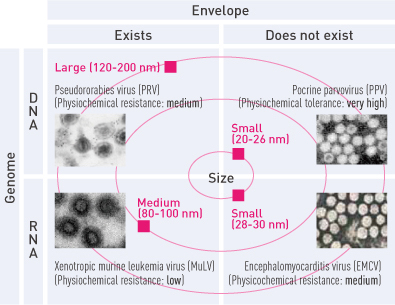
Charact eristics of viruses selected based on the "Virus Clearance Test Guideline (Guideline ICHQ5A, CPMP/BMP/269/95, Pharmaceutical Affairs Bureau #329)"
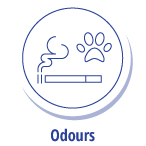
nanoe® X effective in deodorising a busy office
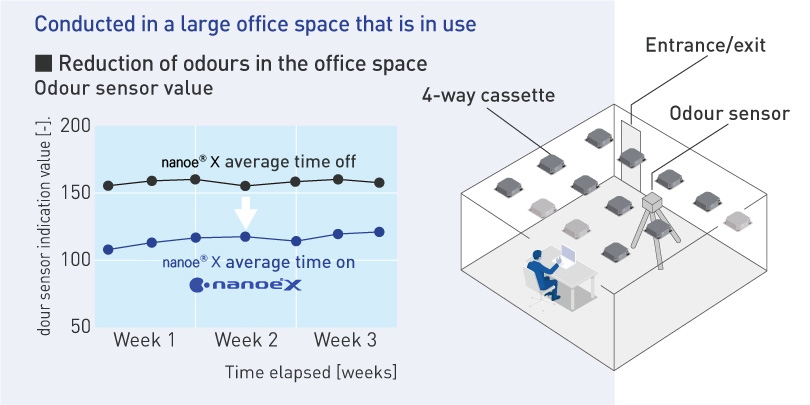
Office odours
(room size: approx. 1,362 m³)
Results
In an office with a simple moving average of 102 employees present, the average odour sensor value was reduced by 40 over a period of 25 days.

Note 1: When the sensor differential is over 40, there is a difference in the level of odour that can be perceived by humans.
Note 2: The calculation of average number of people working in the office includes weekends.
Panasonic internal research. Test method: (1) Continuous cooling operation of air conditioners equipped with nanoe® X in an office for 24 hours without any restriction on human movement. (2) The odour sensor was operated for 24 hours and the values were recorded. (3) The recorded values were calculated as the simple moving average values for 7 days. Test period: 4 weeks with and 4 weeks without nanoe® X. Target: air (odour) in an office.
Test result: When nanoe® X was on, the value indicated by the odour sensor decreased.

nanoe® X reduced odours absorbed by fabrics such as curtains and carpets.
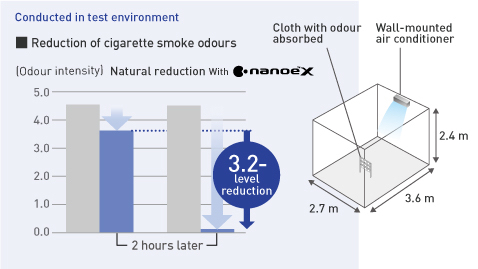
Odour intensity levels 0 Odourless 1 Hardly noticeable 2 Minimally identifiable 3 Immediately noticeable 4 Strong 5 Intensely disagreeable
Cigarette smoke odour
(room size: approx. 10 m²)
Results
After 2 hours there was an odour intensity reduction of approximately 1.0 levels more with nanoe® X than with natural reduction.
Testing organization
Panasonic Product Analysis Center, Japan
(Report No. BAA33-140708-C01)
Tested product: Wall-mounted air conditioner equipped with nanoe® X. Test method: (1) The test air conditioner was installed inside a test chamber measuring approximately 2.73 m x 3.64 m x 2.4 m, or about 10m2. (2) A predetermined number of pieces of cloth (gauze) were hung in an approximately 1m3 box and 20 cigarettes were lit and left for five minutes. (3) The pieces of cloth that had absorbed the cigarette smoke odour were placed at a height of less than 1.2 m approximately 1.5 m away from the air conditioner outlet and the air conditioner was operated in fan mode. (4) The pieces of cloth were collected after a predetermined period and a sensory evaluation was implemented (6-level odour intensity indication method). N = 3 subjects. Target odour: Cigarette smoke.

nanoe® X reduced odours absorbed by fabrics such as curtains and carpets.
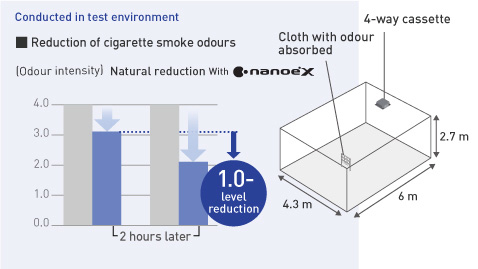
Odour intensity levels 0 Odourless 1 Hardly noticeable 2 Minimally identifiable 3 Immediately noticeable 4 Strong 5 Intensely disagreeable
Cigarette smoke odour
(room size: approx. 25 m²)
Results
After 2 hours there was an odour intensity reduction of approximately 1.0 level more with nanoe® X than with natural reduction.
Testing organization
Panasonic Product Analysis Center, Japan
(Report No. 4AA33-170203-A01)
Tested product: 4-way cassette air conditioner equipped with nanoe® X. Test method: (1) The test air conditioner was installed inside a test chamber measuring approximately 6.02 m x 8 m x 2.9 m, or about 48 m2. (2) A predetermined number of pieces of cloth (gauze) were hung in an approximately 1m3 box and 20 cigarettes were lit and left for five minutes. (3) The pieces of cloth that had absorbed the cigarette smoke odour were placed at a height of less than 1.2 m approximately 1.5 m away from the air conditioner outlet and the air conditioner was operated in fan mode. (4) The pieces of cloth were collected after a predetermined period and a sensory evaluation was implemented (6-level odour intensity indication method). N = 8 subjects. Target odour: Cigarette smoke.

nanoe® X reduced odours absorbed by fabrics such as curtains and carpets.
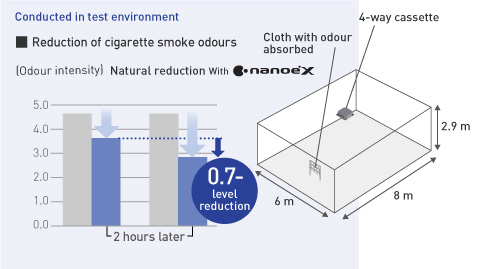
Odour intensity levels 0 Odourless 1 Hardly noticeable 2 Minimally identifiable 3 Immediately noticeable 4 Strong 5 Intensely disagreeable
Cigarette smoke odour
(room size: about 48 m²)
Results
After 2 hours there was an odour intensity reduction of approximately 1.0 level more with nanoe® X than with natural reduction.
Testing organization
Panasonic Product Analysis Center, Japan
(Report No. 4AA33-170203-A01)
Tested product: 4-way cassette air conditioner equipped with nanoe® X. Test method: (1) The test air conditioner was installed inside a test chamber measuring approximately 6.02 m x 8 m x 2.9 m, or about 48mc. (2) A predetermined number of pieces of cloth (gauze) were hung in an approximately 1m3 box and 20 cigarettes were lit and left for five minutes. (3) The pieces of cloth that had absorbed the cigarette smoke odour were placed at a height of less than 1.2 m approximately 1.5 m away from the air conditioner outlet and the air conditioner was operated in fan mode. (4) The pieces of cloth were collected after a predetermined period and a sensory evaluation was implemented (6-level odour intensity indication method). N = 8 subjects. Target odour: Cigarette smoke.

Even in a large area (139 m²) nanoe® X reduced odours absorbed by fabrics such as curtains and carpets.
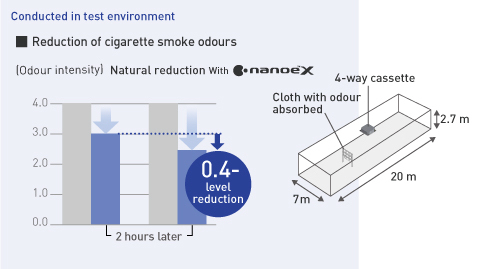
ble 3 Immediately noticeable 4 Strong 5 Intensely disagreeable
Cigarette smoke odour
(room size: approx. 139 m²)
Results
After 2 hours there was an odour intensity reduction of approximately 0.4 level more with nanoe® X than with natural reduction.
Testing organization
Kaken Test Center, Japan
(Report No. KT-19-015089-1)
Tested product: CS-P160U6 4-way cassette air conditioner equipped with nanoe® X. Test method: (1) The test air conditioner was installed inside an old office measuring approximately 7 m x 20 m x 2.7 m, or about 139m2. (2) A predetermined number of pieces of cloth (gauze) were hung in an approximately 1 m3 box and 5 cigarettes were lit and left for one hour. (3) The pieces of cloth that had absorbed the cigarette smoke odour were placed at a height of less than 1 m approximately 3 m away from the air conditioner outlet and the air conditioner was operated in fan mode. (4) Then a sensory evaluation was implemented (6-level odour intensity indication method). N = 9 subjects. Target odour: Cigarette smoke.

nanoe® X broke down PM 2.5-adhering substances in actual space.
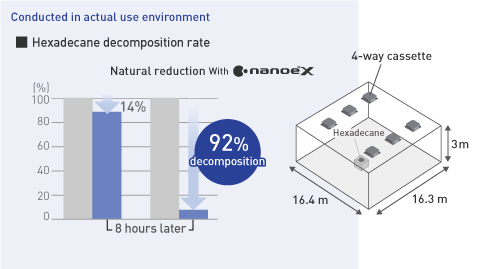
Hexadecane
(PM 2.5-adhering chemical substance)
Results
Operating an air conditioner equipped with nanoe® X broke down more than 92% of particles on average in 8 hours. Air conditioner operation without nanoe® broke down only about 14% of particles.
Testing organization
Report No. ETRC257 / 16 / 14,2 (R479 / 19)
Environmental Technology Research Center
Test product: S-34PU2H5-1 4-way cassette air conditioners equipped with nanoe® X). Test method: (1) Operated six 4-way indoor units installed in a room at a Panasonic Malaysia training centre measuring 16.27 m x16.43 m, or about 267m2. (2) A sample substance with hexadecane adhering to it was placed at a height of 1.2 m in the centre of the room. (3) The air conditioners were operated at an intermediate speed then the sample was collected after the lapse of a predetermined time and GC/MS quantitative analysis was performed. Target: Hexadecane (Alkane)

An indoor unit equipped with nanoe® X installed in an actual space reduced the reading on the odour sensor in the room.
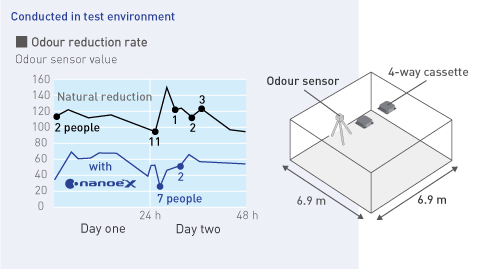
Room odour reduction effects
Results
Odour sensor readings in the room tended to decrease when the nanoe® X device was operated compared to when it was not operated. When the nanoe® X device was not operated, the distinct odour of the room could be perceived when entering the room, but when the nanoe® X device was operated, it could not be perceived.
Conclusion
When a nanoe® X device is operated, odour reduction in the room can be expected.
Internal verification
Tested product: CS-P45U4B 4-way cassette air conditioner equipped with nanoe® X (2 units). Evaluation: October 8, 2019, to October 17, 2019. (1) Verification was performed with the unit installed in a conference room of approximately 47m2. (2) Air conditioner settings: operation mode—cooling; preset temperature—27°C; airflow direction—horizontal; airflow speed— medium (3) Operated nanoe® X device during the first week, then left nanoe® X device off during the second week, then operated the air conditioner. Measured the odour intensity for 2 days each with an electric odour sensor (XP-329m) made by New Cosmos Electric Co., Ltd. (4) The air conditioner was operated for 24 hours and verified. Target: Room odour